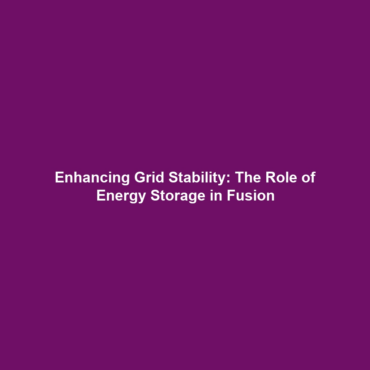<>
Grid Stability and Energy Storage in Fusion Energy
Introduction
Grid stability and energy storage are critical components of modern energy systems, particularly as they relate to the ambitious field of fusion energy. The integration of fusion energy into the grid promises a clean, virtually limitless power source, but it introduces unique challenges in maintaining consistent energy flow. Understanding how grid stability and energy storage interact within this context is vital for harnessing the full potential of fusion energy. This article explores the interplay of these elements, emphasizing their importance for a sustainable energy future.
Key Concepts
Understanding Grid Stability
Grid stability refers to the ability of an electrical grid to maintain consistent operations despite fluctuations in supply and demand. Stability can be categorized into:
- Dynamic Stability: The grid’s ability to recover from disturbances.
- Static Stability: The system’s capacity to maintain equilibrium during normal operations.
The Role of Energy Storage
Energy storage systems (ESS) play a crucial role in enhancing grid stability by absorbing excess energy during peak generation and releasing it during demand spikes. Various technologies for energy storage include:
- Batteries: Lithium-ion and flow batteries are commonly utilized for short-term storage.
- Flywheels: Provide rapid response capabilities for quick energy release.
- Pumped Hydro Storage: Utilizes gravity to convert kinetic energy to potential energy and vice versa.
Applications and Real-World Uses
Significant applications of grid stability and energy storage lie within the realm of fusion energy. For example:
- Load Balancing: Energy storage systems help balance loads by managing fluctuating output from fusion reactors.
- Frequency Regulation: These systems maintain grid frequency by compensating for sudden changes in power supply.
- Energy Arbitrage: Storing energy when generation exceeds demand and discharging it during high demand periods enhances efficiency.
Current Challenges
Despite the advancements in grid stability and energy storage, there are ongoing challenges:
- Scalability Issues: Current energy storage technologies face challenges in scaling to meet widespread fusion energy demands.
- Cost Constraints: High costs associated with advanced storage technologies may limit their commercial viability.
- Integration Difficulties: Integrating new technologies into existing grid infrastructures poses significant hurdles.
Future Research and Innovations
Future research in grid stability and energy storage is expected to yield innovative solutions, including:
- Advanced Battery Technologies: Development of longer-lasting and more efficient battery systems.
- Artificial Intelligence: AI-driven algorithms to optimize energy distribution and storage.
- Decentralized Energy Resources: Future networks of localized energy sources that enhance grid resilience.
Conclusion
Grid stability and energy storage are crucial for the successful integration of fusion energy into our power systems. By addressing current challenges and investing in future innovations, we can pave the way for a more resilient energy grid. For more information on the advancements in fusion energy and its implications for sustainable power, explore our related articles on Fusion Energy and Renewable Energy Storage.

